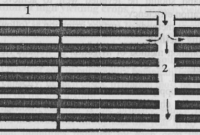This method is suitable for row crops like potato cabbage, cauliflower, brinjal, chilli, sugarcane, cotton, tobacco, tomato etc. water is applied in the furrows which are developed between crop rows in the planting and cultivating processes. There is usually me furrow between each row of crop. In orchards and widely spread vegetable crops, several furrows may be opened between the rows of the crop and the water is led simultaneously in all furrows. Furrows, are laid down along the slope when the slope of the land is about three per cent. The furrows are on graded contour when the slope exceeds three per cent and goes upto 15 per cent. The length of furrow varies with soil type, slope of the land and the quantity of water to l applied and may vary from 10 metres to 100 metres.

Advantages
- There is a great advantage in the use of water which is of great consideration in lift irrigation.
- This method is suitable for crops which are sensitive to saturated soil condition in the root zone.
- Water in the furrows contacts only one fifth to one half of the land surface, thereby reducing puddling, crusting of the soil and evaporation losses.
- Water is applied uniformly by this method.
- It is especially suitable to crops like maize that are injured by contact with water as water does not come in contact with the plant stem.
- The method reduces labour requirements in land preparation and irrigation.
Disadvantages
- Cost involved in the preparation of furrow is more.
- This method is not suitable for all areas, especially cannel areas.
- Uniform distribution of water in all furrows is not possible.
Following are the different types of furrow irrigation system:
- Straight furrow method of irrigation: This method is practiced in flat lands.
- Contour furrow method of irrigation: This method is practiced in sloping land in which the direction of flow is across a slope rather than down slope. The furrows are laid out with a gentle uniform grade to carry the irrigation streams.
- Corrugated furrow irrigation: Corrugations are small furrows which are used for close growing crops such as beet, cabbage, cauliflower, turnip, etc. In this system more and smaller furrows are utilized and crop rows are not necessarily related to the irrigation furrows. The size and spacing of corrugation vary with the soil. The corrugation should be more closely spaced, generally 45 to 90cm.
